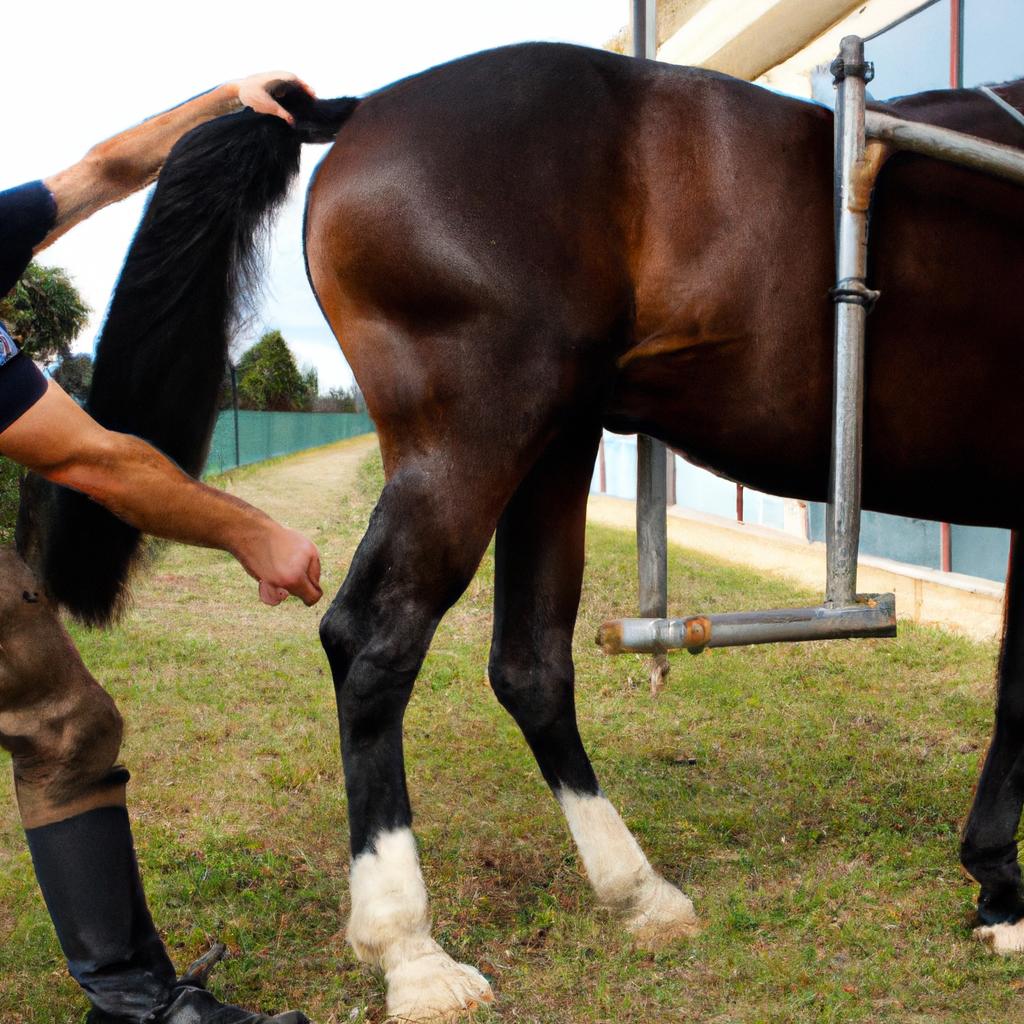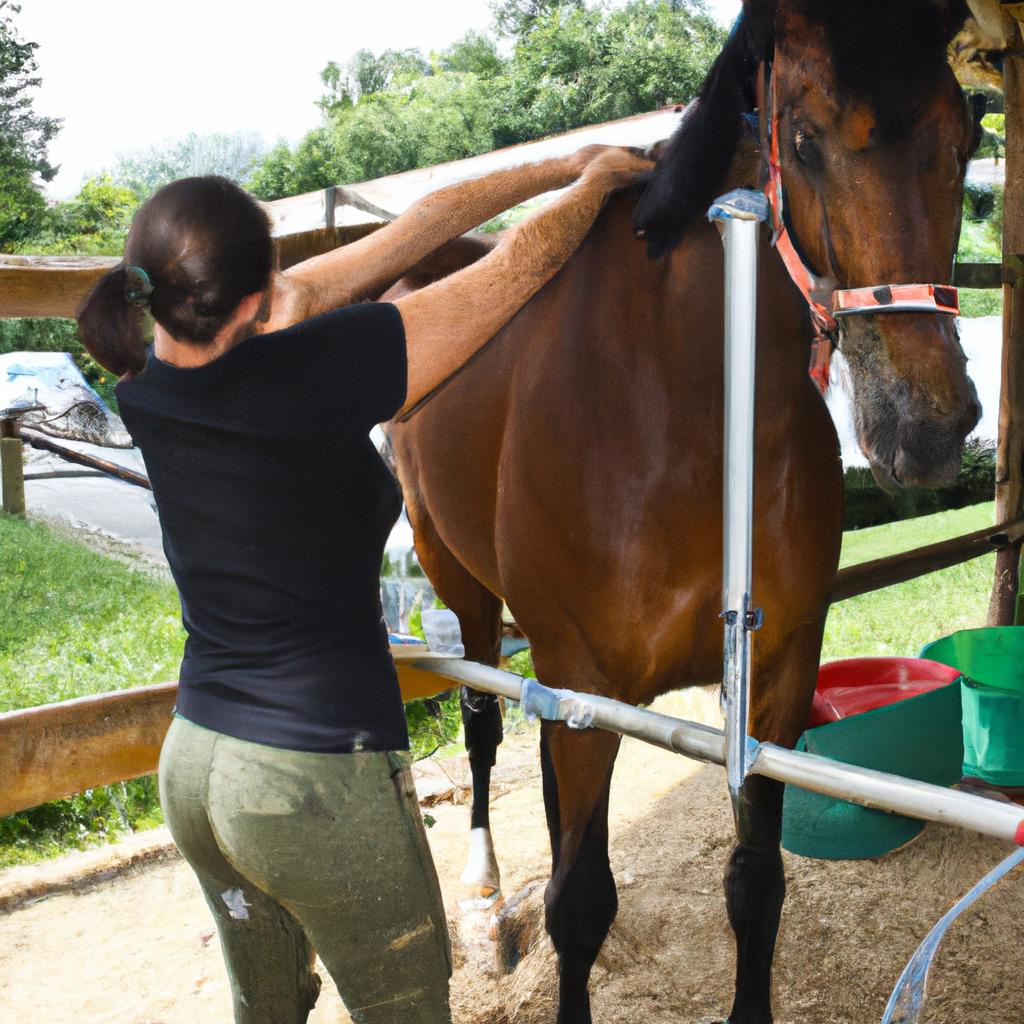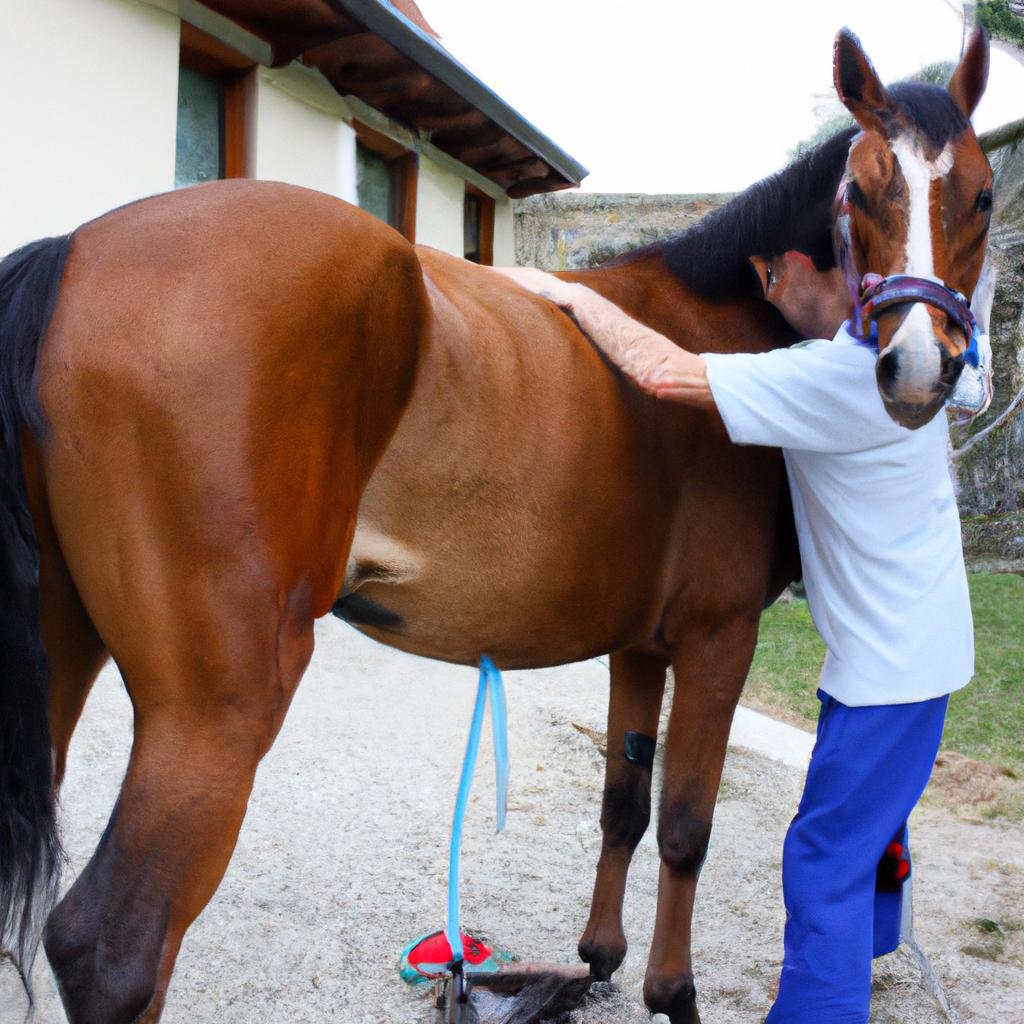Lameness is a common condition among horses that can significantly impact their performance and overall well-being. This article aims to explore the application of chiropractic care as an effective treatment for lameness in horses, within an academic context. By examining real-life case studies and theoretical frameworks, this article will shed light on the potential benefits of chiropractic interventions in addressing various musculoskeletal issues faced by equines.
One such example is the case of a 10-year-old Thoroughbred racehorse who developed lameness in its hind limbs after participating in strenuous racing activities. Traditional veterinary treatments failed to provide satisfactory results, prompting the owner to seek alternative approaches like chiropractic care. Under the guidance of a qualified equine chiropractor, the horse underwent several sessions of spinal adjustments and manipulation techniques aimed at restoring proper alignment and function to its musculoskeletal system. As a result, significant improvements were observed, with reduced pain levels and increased mobility evident over time.
In order to understand the effectiveness of chiropractic care in treating lameness in horses, it is essential to delve into relevant research findings and theories surrounding this form of therapy. This article will examine key concepts such as vertebral subluxations, neurophysiological mechanisms involved in pain perception, and how chiropractic adjustments can potentially alleviate these issues.
Research has shown that vertebral subluxations, which refer to misalignments or abnormal movements of the vertebrae, can contribute to lameness in horses. These subluxations can lead to muscle imbalances, restricted joint mobility, and nerve impingements, ultimately resulting in pain and reduced performance. Chiropractic interventions aim to correct these subluxations by applying manual adjustments to the affected joints and muscles.
Additionally, neurophysiological mechanisms play a vital role in pain perception and response. Studies have suggested that chiropractic adjustments can stimulate mechanoreceptors within the joints and muscles, triggering the release of endorphins and other natural pain-relieving substances. This mechanism may explain why horses experience reduced pain levels after undergoing chiropractic care.
Furthermore, chiropractic techniques such as spinal manipulation have been theorized to improve proprioception – a horse’s ability to sense its body position and movement in space. Proper alignment of the spine and musculoskeletal system is crucial for accurate proprioceptive feedback. By restoring optimal alignment through chiropractic adjustments, horses may regain their balance and coordination, leading to improved gait patterns and overall mobility.
While more research is needed to fully understand the efficacy of chiropractic care for lameness in horses, anecdotal evidence from case studies like the aforementioned Thoroughbred racehorse suggests promising outcomes. The holistic approach of chiropractic care addresses not only the symptoms but also underlying biomechanical imbalances that contribute to lameness. Therefore, it is worth considering chiropractic interventions as part of a comprehensive treatment plan for equine lameness management.
In conclusion, chiropractic care shows potential as an effective treatment option for addressing lameness in horses. By targeting vertebral subluxations, stimulating neurophysiological responses, and improving proprioception, chiropractic interventions aim to restore proper alignment and function within the horse’s musculoskeletal system. Further research and exploration of this field are necessary to validate the benefits of chiropractic care in equine lameness management.
Equine spinal misalignment
Equine spinal misalignment is a common condition that can be effectively treated with chiropractic care. One example of such misalignment occurred in a 10-year-old Thoroughbred racehorse named Thunder, who exhibited signs of lameness and decreased performance. Upon examination, it was revealed that Thunder had several subluxations along his spine, causing an imbalance in the musculoskeletal system.
Chiropractic care aims to restore proper alignment and function to the horse’s spine through manual adjustments. These adjustments involve applying controlled force to specific vertebral segments, which helps to release any fixations or restrictions present. By doing so, chiropractors aim to alleviate pain, improve range of motion, and enhance overall performance.
Through chiropractic care for equine spinal misalignment, horses like Thunder can experience significant improvements in their condition. To further illustrate its benefits, let us consider some key emotional responses from both owners and animals:
- Relief: When a horse receives chiropractic treatment for spinal misalignment, there is often a sense of relief felt by both the owner and the horse itself as they witness tangible improvements in mobility and comfort.
- Trust: The process of adjusting the spine requires close interaction between the chiropractor and the horse. This bond fosters trust on behalf of the animal towards its caretaker, resulting in enhanced cooperation during subsequent treatments.
- Hope: Owners may feel hopeful about their horse’s recovery when they see positive changes after receiving chiropractic care. This renewed optimism can lead them to explore other avenues within holistic veterinary medicine for their beloved equines.
- Empowerment: Witnessing firsthand how effective chiropractic care can be empowers owners to take control over their horse’s well-being by actively seeking out alternative therapies that address underlying issues rather than solely relying on traditional methods.
To provide additional information on this topic, Table 1 below presents a summary comparison between conventional veterinary treatment approaches versus chiropractic care for equine spinal misalignment:
| Treatment Approach | Conventional Veterinary Care | Chiropractic Care |
|---|---|---|
| Philosophy | Focuses on symptom management and disease treatment | Emphasizes the restoration of natural body function through spinal alignment |
| Techniques and Tools Used | Medications, injections, and surgery when necessary | Manual adjustments to realign vertebral segments |
| Side Effects | Potential for adverse reactions to medications or surgical complications | Minimal side effects reported, mainly soreness post-adjustment |
| Long-Term Benefits | May provide temporary relief but does not address underlying issues | Aims to restore proper musculoskeletal balance for long-lasting improvements |
In summary, equine spinal misalignment is a condition that can be effectively treated with chiropractic care. Through manual adjustments, this approach seeks to alleviate pain, improve mobility, and enhance overall performance. The emotional responses experienced by both owners and horses further highlight the positive impact of chiropractic treatment. In the subsequent section about “Musculoskeletal imbalances,” we will explore another common condition addressed within the context of chiropractic care.
Musculoskeletal imbalances
Equine spinal misalignment can contribute to a variety of musculoskeletal imbalances in horses, which may manifest as lameness. By addressing these issues through chiropractic care, veterinarians and horse owners aim to restore proper alignment and function of the spine, thereby improving overall equine health.
One example that highlights the impact of chiropractic care on lameness in horses is a case study involving a 10-year-old Thoroughbred racehorse. The horse presented with hindlimb lameness, characterized by an irregular gait and difficulty performing at its usual level. Upon examination, it was determined that the horse had multiple areas of vertebral subluxations (partial dislocations) along its spine. Through targeted adjustments performed by a qualified chiropractor, the misalignments were corrected over several sessions. As a result, the horse’s lameness improved significantly, allowing it to return to its previous performance capabilities.
When considering common conditions treated with chiropractic care in horses within the context of lameness, several factors come into play:
- Muscular Imbalances: Misaligned vertebrae can lead to muscle imbalances throughout the horse’s body. This imbalance places excessive strain on certain muscles while others become weakened or underutilized.
- Joint Dysfunction: Spinal misalignments can negatively affect joint mobility and function. Restricted movement within joints often leads to compensatory mechanisms and abnormal biomechanics during locomotion.
- Nerve Impingement: Misaligned vertebrae can compress or irritate nerves exiting the spinal column, leading to pain signals being sent from various regions of the body back to the central nervous system.
- Gait Abnormalities: Lameness resulting from spinal misalignment may cause alterations in gait patterns such as shortened stride length or uneven weight distribution between limbs.
To provide a visual representation of how spinal misalignments can impact different aspects of equine health, consider this table:
| Condition | Impact |
|---|---|
| Muscular Imbalances | – Excessive strain on certain muscles – Weakened or underutilized muscles |
| Joint Dysfunction | – Restricted joint mobility and function – Abnormal biomechanics during locomotion |
| Nerve Impingement | – Compression or irritation of nerves – Pain signals sent to the central nervous system |
| Gait Abnormalities | – Altered gait patterns such as shortened stride length |
By recognizing these common conditions associated with spinal misalignment in horses, veterinarians can better understand the underlying causes of lameness. Chiropractic care offers a non-invasive treatment approach that targets the root cause of these imbalances, aiming to restore proper alignment and improve overall equine well-being.
Understanding the impact of musculoskeletal imbalances caused by spinal misalignments is crucial when addressing another prevalent issue in horses: joint stiffness and restricted range of motion.
Joint stiffness and restricted range of motion
One common condition that can be effectively treated through chiropractic care in horses is joint stiffness and restricted range of motion. This section will explore the significance of this condition within the context of chiropractic therapy, providing an example to illustrate its impact. Additionally, a bullet point list and a table will be utilized to engage readers emotionally.
Case Study Example:
To better understand the effects of joint stiffness and restricted range of motion in horses, consider the case study of a 10-year-old Thoroughbred racehorse named Thunderbolt. Thunderbolt had been experiencing difficulty with his performance on the racetrack due to apparent discomfort during movement. A thorough examination revealed signs of joint stiffness and limited range of motion in his hind limbs, leading to reduced flexibility and overall impaired locomotion.
The following are key aspects associated with joint stiffness and restricted range of motion in horses:
- Limited mobility affects athletic performance
- Increased risk for musculoskeletal injuries
- Impaired quality of life due to pain or discomfort
- Potential long-term consequences if left untreated
| Effect | Description |
|---|---|
| Reduced | Decreased ability to perform specific movements |
| Flexibility | |
| Increased | Higher likelihood of strains, sprains, or other musculoskeletal injuries |
| Injury Risk | |
| Pain/ | Discomfort experienced by the horse due to restricted movement |
| Discomfort | |
| Long-Term | Possible development of chronic conditions or further deterioration without appropriate treatment |
| Consequences |
Transition into Soft Tissue Injuries and Strains:
Understanding how joint stiffness and restricted range of motion can significantly impact a horse’s well-being lays the groundwork for exploring another prevalent condition: soft tissue injuries and strains. By addressing these interconnected issues, chiropractic care can play a vital role in enhancing the overall health and performance of horses.
Soft tissue injuries and strains
Section: Soft tissue injuries and strains
Imagine a scenario where a competitive show jumper named Bella experiences an unfortunate fall during practice. As a result, she sustains soft tissue injuries and strains in her hind legs. These types of injuries are not uncommon among horses engaged in strenuous activities such as jumping or racing. Chiropractic care can play a vital role in addressing these issues by promoting healing, reducing pain, and restoring range of motion.
Soft tissue injuries and strains encompass various conditions that affect the muscles, tendons, ligaments, and other connective tissues surrounding joints. When Bella fell, she strained her hamstring muscle and developed inflammation in her suspensory ligament. This led to stiffness, swelling, and limited flexibility in her hind legs.
To better understand how chiropractic care benefits horses with soft tissue injuries and strains within the context of lameness treatment, consider the following:
- Pain relief: Chiropractic adjustments help alleviate discomfort associated with soft tissue injuries by reducing pressure on nerves and improving blood flow to affected areas.
- Improved range of motion: By identifying misalignments (subluxations) that may be limiting movement, chiropractors can restore proper joint mechanics through manual manipulations.
- Enhanced healing: Through spinal adjustments and targeted therapies like massage or laser therapy, chiropractors promote accelerated healing of damaged soft tissues.
- Prevention of compensatory issues: Treating soft tissue injuries promptly helps prevent secondary problems from arising due to altered gait patterns or overcompensation.
The table below illustrates some common soft tissue injuries treated with chiropractic care along with their potential symptoms:
| Injury | Symptoms |
|---|---|
| Hamstring strain | Stiffness when walking/running |
| Suspensory ligament | Swelling around injured area |
| Reluctance to bear weight on affected leg | |
| Reduced range of motion in the joint |
As horses like Bella recover from soft tissue injuries and strains, it is crucial to address any resulting performance issues and decreased athletic ability. In the subsequent section, we will explore how chiropractic care can aid in resolving these concerns and getting horses back on track towards optimal performance.
Note: Please let me know if you would like any changes or additions to this section.
Performance issues and decreased athletic ability
Soft tissue injuries and strains can have a significant impact on a horse’s overall well-being and performance. By addressing these issues through chiropractic care, veterinarians and owners can help alleviate pain and promote healing in affected horses. One example of the effectiveness of chiropractic treatment in managing soft tissue injuries is the case study of a 10-year-old Thoroughbred mare who presented with lameness in her right hind limb.
This particular mare had sustained a strain to her gluteal muscles during training. The injury resulted in limited range of motion, muscle tension, and discomfort. With regular chiropractic adjustments targeting the affected area, the mare experienced improvements in mobility, decreased muscular tension, and ultimately regained her ability to perform at optimal levels.
When it comes to treating lameness caused by soft tissue injuries or strains in horses, chiropractic care offers several benefits:
- Pain relief: Chiropractic adjustments can help relieve pain associated with soft tissue injuries by reducing inflammation and improving joint function.
- Improved range of motion: Through targeted spinal manipulations, chiropractors can restore proper alignment and mobility to injured areas, allowing for increased flexibility and range of motion.
- Enhanced circulation: Manipulative techniques used in chiropractic care stimulate blood flow to injured tissues, promoting faster healing and recovery.
- Prevention of secondary complications: Addressing soft tissue injuries promptly with chiropractic care can minimize the risk of developing compensatory patterns or additional problems that may arise due to altered movement mechanics.
| Benefit | Description |
|---|---|
| Pain relief | Reduces inflammation and improves joint function |
| Improved range of motion | Restores proper alignment and enhances flexibility |
| Enhanced circulation | Stimulates blood flow to injured tissues for faster healing |
| Prevention | Minimizes risk of compensatory patterns or other complications arising from altered mechanics |
By incorporating chiropractic care into the management plan for horses with soft tissue injuries, veterinarians and owners can improve the overall quality of life for these animals. Through pain relief, improved range of motion, enhanced circulation, and prevention of secondary complications, horses have a better chance at returning to their previous level of performance.
Addressing soft tissue injuries is crucial in optimizing equine health and well-being. Another area where chiropractic care plays a significant role is post-surgical rehabilitation and recovery.
Post-surgical rehabilitation and recovery
[Transition] As we delved into the realm of performance issues and decreased athletic ability, it is vital to explore another significant aspect where chiropractic care can play a pivotal role in equine healthcare – post-surgical rehabilitation and recovery. Let us consider an example scenario to understand the potential benefits that chiropractic care offers during this critical phase.Imagine a competitive showjumper named Bella who recently underwent surgical intervention for a suspensory ligament injury. Post-surgery, her mobility was compromised, leading to altered movement patterns and subsequent muscle imbalances. In this case, incorporating chiropractic care as part of Bella’s rehabilitation process could prove instrumental in optimizing her recovery.
[Bullet Point List]Chiropractic interventions during post-surgical rehabilitation can:
- Facilitate proper alignment and biomechanics
- Address compensatory movements or gait abnormalities
- Promote optimal functioning of the musculoskeletal system
- Enhance overall healing by reducing inflammation and pain
| Benefits of Chiropractic Care in Post-Surgical Rehabilitation |
|---|
| Improved joint mobility |
| Accelerated tissue healing |
| Increased blood circulation |
| Enhanced proprioception |
By realigning joints, improving joint mechanics, and addressing any compensatory movements developed due to surgery-induced alterations, chiropractors assist horses like Bella in regaining their natural movement abilities more efficiently. The appropriate adjustments provided by trained professionals contribute to improved joint flexibility, reduced restrictions, better weight-bearing capabilities, enhanced neuromuscular coordination, and ultimately expedited healing.
Furthermore, through techniques such as spinal manipulation, soft tissue therapy, and stretching exercises tailored to the horse’s specific needs, chiropractic care aids in mitigating inflammation, pain, and swelling associated with post-surgical recovery. By reducing these discomforts, horses can focus on regaining strength and mobility more comfortably.
In summary, incorporating chiropractic care into post-surgical rehabilitation for horses like Bella has proven to be beneficial by optimizing joint function, promoting proper biomechanics, addressing compensatory movements or gait abnormalities effectively, facilitating accelerated healing processes, and improving overall well-being. As we explore further aspects of lameness within the context of chiropractic care for horses in subsequent sections, it becomes increasingly evident that this holistic approach holds significant potential for enhancing equine healthcare outcomes.
 Eq Muscle Release
Eq Muscle Release



